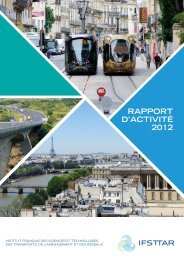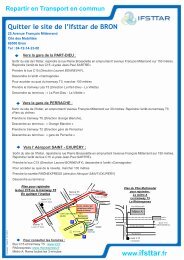french institute of science and technology for transport ... - Ifsttar
french institute of science and technology for transport ... - Ifsttar
french institute of science and technology for transport ... - Ifsttar
You also want an ePaper? Increase the reach of your titles
YUMPU automatically turns print PDFs into web optimized ePapers that Google loves.
2_SCIENTIFIC AND TECHNICAL ACTIVITIES<br />
Acceleration (gals)<br />
700<br />
600<br />
400<br />
200<br />
0<br />
a<br />
CHB024 (Vs30 = 248.5 m/s)<br />
liquefaction<br />
The major<br />
earthquake<br />
in Japan<br />
Analyzing ground<br />
movements<br />
-200<br />
10.0<br />
ESD in horizontal plane (S-trans<strong>for</strong>m)<br />
Ew<br />
NS<br />
On 11 March 2011, an Mw 9 earthquake struck the<br />
East coast <strong>of</strong> Japan. This was the strongest tremor that<br />
has been felt in the country <strong>and</strong> one <strong>of</strong> the largest earthquakes<br />
to have occurred since seismological measurements<br />
began.<br />
50<br />
Frequency (Hz)<br />
Acceleration (gals)<br />
Normalized Acceleration<br />
1.0<br />
0.1<br />
4 000<br />
2 000<br />
1 000<br />
-1 000<br />
50 100 150 200 250<br />
b<br />
Time (s)<br />
MyGH10 (Vs30 = 347 m/s)<br />
3 000 NS2<br />
0<br />
1.0<br />
0.5<br />
0.0<br />
-0.5<br />
-1.0<br />
0<br />
500 1 000 1 500 2 000 2 500<br />
Evolution <strong>of</strong> predominant frequency<br />
500 1000 1500<br />
2000 2500<br />
Times (s)<br />
Ew2<br />
NS1<br />
Ew1<br />
15<br />
14<br />
13<br />
12<br />
11<br />
10<br />
9<br />
8<br />
7<br />
6<br />
5<br />
Frequency (Hz)<br />
Japan’s exceptional instrumentation system, consisting<br />
<strong>of</strong> roughly 1000 accelerometric stations on the surface (the<br />
K-NET network) <strong>and</strong> 700 seismograph pairs located on the<br />
surface <strong>and</strong> in boreholes (KiK network) meant that this large<br />
earthquake was the best recorded in the world, from distances<br />
that were close to the fault plane (40 – 50 km).<br />
The recordings show that the strong movements lasted approximately<br />
3 minutes, with a maximum ground acceleration<br />
value at sites near the fault plane that <strong>of</strong>ten exceeded 1g. This<br />
combination <strong>of</strong> factors led to the mobilization <strong>of</strong> interstitial pressure<br />
which was responsible <strong>for</strong> cyclic mobility <strong>and</strong> liquefaction<br />
at the regional level (Figure a). The ANR ONAMAZU project,<br />
which got under way in October 2011, brings together partners<br />
from France <strong>and</strong> Japan in order to conduct a thorough analysis<br />
<strong>of</strong> the ground movements that were recorded during the earthquake.<br />
This research involves IFSTTAR, BRGM, IRSN <strong>and</strong><br />
CETE Méditerranée in France <strong>and</strong> DPRI, NIED <strong>and</strong> Shimizu<br />
Corp in Japan. The project began with the construction <strong>of</strong><br />
a database containing accelerometer measurements from<br />
the mainshock <strong>and</strong> the aftershocks. This was used to compute,<br />
amongst other things, the response <strong>of</strong> the soil at station<br />
MYGH10 (Figure b), which shows that the medium did not<br />
return its initial state after the principal event. The intention is<br />
<strong>for</strong> the project now to conduct a fuller study <strong>of</strong> this phenomenon<br />
in order to calibrate constitutive models <strong>for</strong> soil under<br />
seismic loading.<br />
@ CONTACT<br />
fabian.bonilla@ifsttar.fr<br />
Figure a. Time-frequency analysis <strong>of</strong> the recordings <strong>of</strong> station CHB024<br />
(Chiba Prefecture). The signals show the effect <strong>of</strong> cyclic mobility (high frequency<br />
peaks between 120 <strong>and</strong> 130 s) <strong>and</strong> liquefaction (after 130 s).<br />
Figure b. Change in response over time in the case <strong>of</strong> the soil under station<br />
MYGH10 (predominant frequency). Note the sharp drop in frequency during the<br />
mainshock <strong>and</strong> the slow recovery during the first 45 minutes <strong>of</strong> the recording.<br />
ifsttar French <strong>institute</strong> <strong>of</strong> <strong>science</strong> <strong>and</strong> <strong>technology</strong> <strong>for</strong> <strong>transport</strong>, development <strong>and</strong> networks






![Trajectoire le magazine n°3 - Juillet 2012 [.pdf] - Ifsttar](https://img.yumpu.com/30038493/1/190x253/trajectoire-le-magazine-na3-juillet-2012-pdf-ifsttar.jpg?quality=85)

